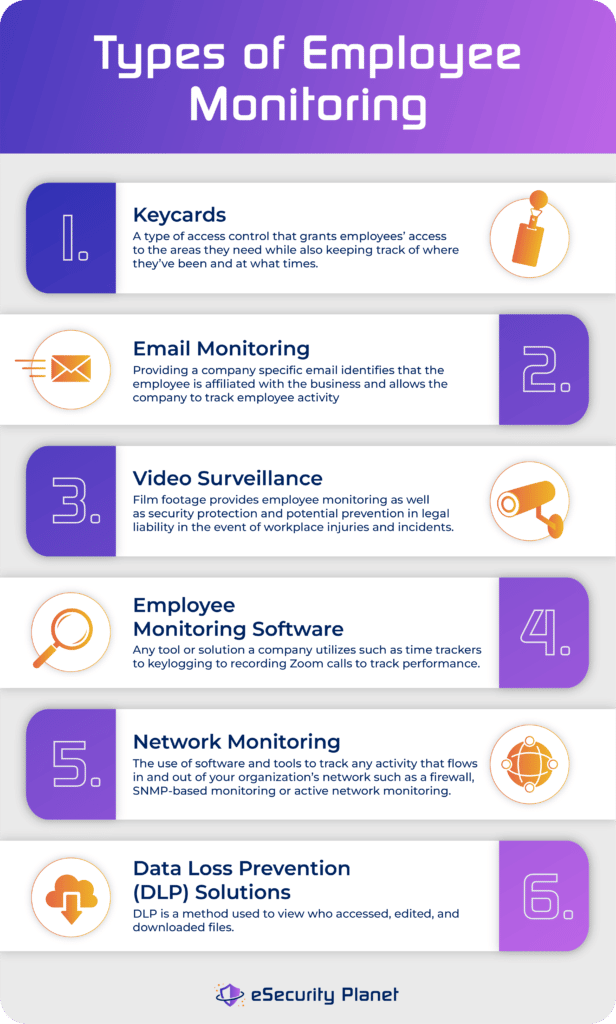Businesses have long wondered if employees are staying focused and doing their jobs. To answer this question, many in the modern age have turned to employee monitoring software.
From facial recognition to surveillance cameras to time trackers to just having a couple guys standing over employees’ shoulders, there are a multitude of ways to make sure employees are staying on-task and being productive. With the massive shift toward remote and hybrid workplaces in the wake of the COVID-19 pandemic, employee monitoring software became bigger than ever. According to a study conducted by StandOut CV, 1 in 5 companies are using some sort of employee monitoring tool.
However, some techniques are more questionable, expensive, or impractical than others, and it can be difficult to figure out which is which in isolation. Below, we’ll cover the good, the bad, and the just plain creepy of employee monitoring — along with consequences, both intended and unintended — to help you find the best way to make sure your employees are on-task.
What is Employee Monitoring and Why Use It?
Employee monitoring’s definition is in the name: it’s the surveillance of your workers using a variety of techniques and tools. These can come in a variety of forms we’ll discuss in more detail below, but the most common in a modern office setting is software monitoring, where a piece of software is installed onto employees’ computers, which can then track things such as web activity.
There are a number of reasons to implement employee monitoring in an organization. The most obvious is performance tracking. If you’re worried your employees aren’t doing their jobs correctly, employee monitoring techniques can help relieve those anxieties. There are also security concerns, such as to protect trade secrets or to avoid legal liability in the event of a workplace injury or incident.

Want to Find a DLP Solution That’s Right for You? Check Out Top Data Loss Prevention Solutions
Benefits of Employee Monitoring
The benefits of employee monitoring can vary depending on the needs of the organization. For example, a 2014 article for Forbes laid out the benefits semi-truck companies can have when implementing employee monitoring systems, specifically a potential reduction in the frequency and severity of crashes. It also allowed companies to adapt to a then-recent tightening of hours-of-service (HOS) regulations.
There can also be health benefits of employee monitoring, when extended to out-of-work programs like Castlight Health’s healthcare navigation platform, which analyzes employee’s self-reported behavior, self-assessments, and health-related online searches to help employees make healthier decisions in their day-to-day life. Fitbit and similar technology can be used to track employees’ exercise routines, with some companies even offering rewards like extra days off for good behavior. Healthy employees tend to be sharper and more productive; so the benefits in encouraging healthy activity can be great for a business.
Want to Make Sure Remote Workers Can Access Your Network Securely? Check Out Secure Access for Remote Workers: RDP, VPN & VDI
Does Employee Monitoring Increase Productivity?
The big question for many organizations is whether employee monitoring tools make employees more productive. This is a common selling point of the technology, but is there evidence backing up these claims?
This question has been studied in depth since computers and the monitoring capabilities they provide first entered the workplace in the 1980s. In short, the results are mixed. In a 1986 study published in “Communications of the ACM,” the authors noted, “Some [managers] see positive effects, such as increased productivity, a more accurate assessment of employee performance, and greater organizational control over workers.”
However, they also go on to state, “the introduction of computerized performance monitoring may result in a workplace that is less satisfying to many employees . . . [and] creates a more competitive environment which may decrease the quality of social relationships.”
For a more recent example, Akron-based Afton Manufacturing implemented RFID sensors in the late 2010s and reported saving a minimum of 300 work hours in the first year, providing the company with $6,000 in increased productivity.
However, Susan Schumacher’s 2011 article published in ESSAI titled “What Employees Should Know About Electronic Performance Monitoring” calls the oft-claimed productivity increases into question:
“…studies show that while monitoring may produce some positive short-term results on productivity, the long-term negative effect on the workplace deteriorates the relationships between management and workers and causes unnecessary stress, and emotional and physical health problems for employees.”
Schumacher also noted:
“The majority of the quantitative information written about EPM weighs heavily in favor of businesses: companies protecting themselves from information leaks, non-company related internet usage that reduces employee productivity, increases in a company’s risk of network crippling viruses, and breach[es] that threaten confidential information. In contrast, few reports have quantified the emotional and physical effects on employees or offered suggestions to help relieve or reduce the stress-related symptoms.”
While the article was written in 2011, the lion’s share of information on the topic of employee monitoring still belongs to businesses. Whether it’s companies like Afton Manufacturing praising the number of work hours saved or this 2014 service industry study claiming that monitoring makes employees work harder while also admitting that these systems can have an adverse effect on employees’ ability to make ends meet: “The loss of even small amounts of income can substantially impact the worker’s ability to meet basic living expenses.”
This imbalance in information can make it difficult to quantify how much of a positive effect employee monitoring has on productivity in the long-term, as the information coming from businesses rarely balances the detrimental effect these tools may have on employees’ mental and physical well-being and job satisfaction compared with any short-term gains in productivity they report. Employees’ job satisfaction, it should be noted, is something with well-documented positive effects on their productivity.
Want More Ways to Keep Your Remote Workers Secure? Take a Look at Remote Work Security: Priorities & Projects
Disadvantages of Employee Monitoring
The main disadvantages of employee monitoring involve the effects it has on employees. Employee monitoring in modern workplaces is often compared to the concept of the “panopticon,” a hypothetical prison proposed by 18th century English philosopher Jeremy Bentham. The concept behind Bentham’s “panopticon” is a prison which would allow a single security guard to maintain observation of an entire prison population without prisoners knowing they are being watched.
This comparison, common though it is, remains apt. The sheer number of options employers have at their disposal in the modern employee monitoring space makes it difficult for employees to fully understand when they are being monitored and why.
An example of this is found in the case of Myrna Arias, detailed in a 2018 study on “Evidence-Based Recommendations for Employee Performance Monitoring.” Arias was hired by American money-transferring firm Intermex, which required her to download Xora, a “mobile resource management application… that provides useful on-the-go web services for employees that often engage in client-related communication and travel.”
While the app’s use during work hours provided useful data on employee activity, Xora collected location data from users 24/7. When Arias objected to this constant monitoring of her life and asked for the feature to be turned off outside of work hours, her manager was insistent that the app remain on 24/7 in order to efficiently function. The manager went on to boast that he could use the app’s tracking features to see how fast Arias was driving at any time, which speaks to tracking apps like Xora’s potential for abuse by management and others with access to its data.
After management denied her request to turn off Xora’s tracking capabilities outside of work hours, Arias turned the app off herself, which led to her being fired for noncompliance. The resulting lawsuit between Arias and Intermex resulted in an out of court settlement. While the details of the settlement weren’t disclosed, Arias was seeking $500,000 in damages due to lost wages in the lawsuit.
A large amount of academic literature, both past and present, purports that any benefits of employee monitoring are outweighed by the disadvantages. In a 2000 article published in “Business Ethics Quarterly,” Professor Adam D. Moore states, “While this kind of employee monitoring may yield some benefits, the preponderance of the evidence would suggest otherwise. Some studies have shown that these monitoring systems produce fear, resentment, and elevate stress levels.”
A central problem with employee monitoring and specifically modern employee monitoring software, is its potential for the dehumanization of workers into collections of statistics. As Ivan Manokha put it in his 2020 paper published in “Surveillance & Society”: “…what we are dealing with is the process of the transformation of human workers into things with objective indicators such as productivity levels, physical shape, cognitive characteristics and various aggregates of these measures that compute a comparative worth of each employee with respect to other.”
How to Monitor Employee Productivity Right
In short, it would probably be best if you didn’t monitor your employees too much, but, if you feel you must, there are some steps you can take to do so ethically and to minimize harm. The previously-mentioned study “Evidence-Based Recommendations for Employee Performance Monitoring” provides a number of excellent suggestions in this area:
- Be transparent with your use of employee monitoring: Employee monitoring software can look very similar to spyware, a type of malware used by hackers to track user activity and steal their data. The main difference is that, unlike a hacker, companies have an ethical obligation to secure employees’ consent before implementing this software and, ideally, would not put this software onto employees’ personal devices. Securing informed consent from employees, making them fully aware of the monitoring you will be performing on them, is an absolute must.
- Make sure it’s necessary: Only implement monitoring if it “is crucial to organizational functioning because monitoring typically elicits negative responses regardless of implementation.”
- Development, not punishment: “Use EPM for learning and development rather than deterrence,” the study cautions. Using the software purely as a punitive tool can increase the adverse effects employee monitoring can potentially inflict on employees. Utilizing it instead to provide developmental suggestions and to engineer employee growth can produce the productivity increases you want with less potential for harm.
- Restrict EPM use to work-related behaviors: As the above Myrna Arias-Intermex case details, it’s important that you “restrict EPM to only work-related behaviors.” Avoid using employee monitoring when employees aren’t on-site and not engaging in work-related activity.
- Keep your organization’s structure in mind: This can include the size of your company, the sort of work the company does, and the characteristic duties your employees carry out on a day-to-day basis. Make sure, especially for larger businesses, that the system is clearly communicated and described at all levels of the company, top to bottom. This is not the sort of system you should be implementing on a whim. You will also need to “[c]onsider the characteristics of the job—complex jobs that require more freedom and autonomy for core tasks will need EPM systems that do not block crucial activities.”
Overall, monitoring can be a dangerous game to play with employees because your workers are people with their own thoughts, desires, and lives outside of the workplace. They are not abstract bodies of productivity scores and performance evaluations to be analyzed by artificial intelligence, and if they are capable of doing so, they will leave if they feel they are being mistreated or dehumanized.
Running a business can be as much an emotional effort as it is an analytical one, and it’s ultimately up to you to determine if the potential gains that monitoring techniques may bring are worth the potential harm they can inflict on your employees’ well-being and morale.
Read Next: Businesses Secretly Pentest Partners as Supply Chain Fears Grow





















 Top Cybersecurity CompaniesThe cybersecurity industry is constantly evolving. Learn about the top cybersecurity companies and what each does best.Link to Threat Intelligence Platforms
Top Cybersecurity CompaniesThe cybersecurity industry is constantly evolving. Learn about the top cybersecurity companies and what each does best.Link to Threat Intelligence Platforms Threat Intelligence PlatformsThreat intelligence platforms help analyze and share cyber threat data. Discover top TIPs , their features, use cases, and comparisons.Link to GRC Tools
Threat Intelligence PlatformsThreat intelligence platforms help analyze and share cyber threat data. Discover top TIPs , their features, use cases, and comparisons.Link to GRC Tools GRC ToolsDiscover the top governance, risk and compliance (GRC) tools and software to help identify products that may suit your enterprise's needs.Link to Network Access Control Solutions
GRC ToolsDiscover the top governance, risk and compliance (GRC) tools and software to help identify products that may suit your enterprise's needs.Link to Network Access Control Solutions Network Access Control SolutionsExplore the top NAC solutions to ensure your network is only accessed by trusted users and avoid unwanted risks.Link to Top NGFW
Network Access Control SolutionsExplore the top NAC solutions to ensure your network is only accessed by trusted users and avoid unwanted risks.Link to Top NGFW Top NGFWExplore the top next-generation firewall solutions. Assess features and pricing to discover the ideal NGFW solution for your needs.Link to EDR Solutions
Top NGFWExplore the top next-generation firewall solutions. Assess features and pricing to discover the ideal NGFW solution for your needs.Link to EDR Solutions EDR SolutionsEDR solutions ensure an organization's endpoints are running properly by monitoring and troubleshooting tech on the network. Compare the top tools now.
EDR SolutionsEDR solutions ensure an organization's endpoints are running properly by monitoring and troubleshooting tech on the network. Compare the top tools now. What is Network Security? Definition, Threats & ProtectionsLearn about the fundamentals of network security and how to protect your organization from cyber threats.Link to Network Protection: How to Secure a Network in 13 Steps
What is Network Security? Definition, Threats & ProtectionsLearn about the fundamentals of network security and how to protect your organization from cyber threats.Link to Network Protection: How to Secure a Network in 13 Steps Network Protection: How to Secure a Network in 13 StepsSecuring a network is a continuous process. Discover the process of securing networks from unwanted threats.Link to Top 19 Network Security Threats + Defenses for Each
Network Protection: How to Secure a Network in 13 StepsSecuring a network is a continuous process. Discover the process of securing networks from unwanted threats.Link to Top 19 Network Security Threats + Defenses for Each Top 19 Network Security Threats + Defenses for EachDiscover the most common network security threats and how to protect your organization against them.Link to 34 Most Common Types of Network Security Solutions
Top 19 Network Security Threats + Defenses for EachDiscover the most common network security threats and how to protect your organization against them.Link to 34 Most Common Types of Network Security Solutions 34 Most Common Types of Network Security SolutionsLearn about the different types of network security and the different ways to protect your network.
34 Most Common Types of Network Security SolutionsLearn about the different types of network security and the different ways to protect your network.









